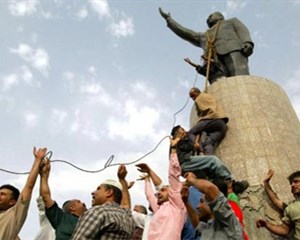Around 6.50pm the M-88 drove away from the statue, dragging it face forward with the chain around its neck. Slowly, the bronze bent forward at the knee and ankle, Saddam's huge figure bobbing for a few seconds in a horizontal position as the modest crowd of Iraqis whistled and cheered. Finally, the statue snapped off its plinth, leaving its feet behind. Iraqis ran forward, jumped on it and danced. It was crushed to pieces.
下午6點50分左右,M-88裝甲車駛離雕像,掛著鐵鏈,臉朝前拖著雕像。慢慢地,銅像的膝蓋和腳踝處向前彎了彎,薩達姆的巨大身軀在水平位置上下浮動了幾秒鐘,而為數不多的一群伊拉克人吹起了口哨,歡呼起來。最后,雕像折斷了底座,把腳留在了后面。伊拉克人向前跑,在上面跳來跳去。它被壓成了碎片。
That morning, photojournalist Patrick Baz had been in Saddam City (a neighbourhood of Baghdad later renamed Sadr City). There, he had seen an Iraqi man who had pulled down a different Saddam statue. It was tied to the back of his car with a cable.
那天早上,攝影記者帕特里克·巴茲來到了薩達姆城(巴格達的一個街區,后來改名為薩德爾城)。在那里,他看到一個伊拉克人將纜繩綁在他的車后面,推倒了另一座薩達姆雕像。
Whenever the man saw a group of people, he would stop. They would all crowd around Saddam and start hitting him with their shoes. (Shoes are considered dirty in the Middle East: it is rude to show someone the soles of your shoes, and a terrible insult to hit them with a shoe. In 2008, an Iraqi journalist would make international news when he threw a shoe at George W Bush.)
每當這個人看到一群人時他就會停下來。他們會圍著薩達姆,開始用鞋子打他。(在中東,鞋子被認為是臟的:讓別人看你的鞋底是不禮貌的,用鞋子打別人是一種嚴重的侮辱。2008年,一名伊拉克記者向喬治·W·布什扔鞋,這件事成了國際新聞。)

"The image was all the more strong because there wasn't an American soldier in sight," Baz later wrote. "Just the locals expressing what they felt about their country's long-term dictator." Baz hurried back to his room at the Palestine Hotel to send his pictures to his editors, then heard a commotion outside and witnessed the Firdos Square toppling. Only one of the Saddam topplings made the front pages, and it was not the one that Iraqis had done for themselves. There was a real story here about pulling down a statue in Saddam City. The world's media preferred the simulation in Firdos Square.
巴茲后來寫道:“因為視野里沒有一名美國士兵,所以畫面更加強烈。只是當地人表達了他們對長期擔任了這個國家的獨裁者的感受。”巴茲急忙回到他在巴勒斯坦酒店的房間,把他的照片發給他的編輯,然后聽到外面的騷動,并目睹了佛多斯廣場的倒塌。在推翻薩達姆政權的事件中,只有一次事件登上了頭版,而且不是伊拉克人為自己所做的。這里有一個關于推倒薩達姆城一座雕像的真實故事。世界媒體更喜歡佛多斯廣場的模擬。
As two hours of non-stop coverage of Firdos Square was beamed around the world that night, the news networks desperately wanted it to have a meaning. Wolf Blitzer of CNN described the footage as "the image that sums up the day and, in many ways, the war itself". Over on Fox, the anchors agreed. "This transcends anything I've ever seen," said Brit Hume. His colleague agreed: "The important story of the day is this historic shot you are looking at, a noose around the neck of Saddam, put there by the people of Baghdad." But it was an American rope, put there by American soldiers.
當天晚上,隨著對佛多斯廣場長達兩個小時的不間斷報道傳遍全球,新聞網絡迫切希望它有意義。美國有線電視新聞網(CNN)的沃爾夫·布利澤將這段視頻描述為“總結了這一天,在很多方面,也總結了戰爭本身”。在福克斯,主持人同意了。布里特·休姆說:“這超越了我所見過的任何東西。”他的同事對此表示贊同:“今天最重要的新聞就是你看到的這一具歷史意義的槍決,這是巴格達人民套在薩達姆脖子上的絞索。”但那是美國的繩子,是美國士兵放上去的。











